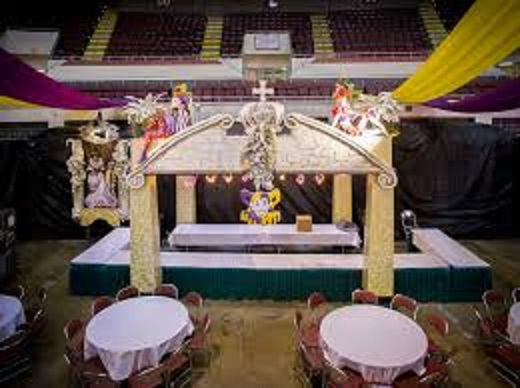Over seven days back, the evening of the Order of Inca ball, Ron Barrett moved to the Mobile Civic Center gallery just because this Carnival season. What they saw circling the field floor underneath blew their mind.
“These monuments were rising up out of 1,000 people, like you see in Rome,” Barrett recalled. “And I was stunned at being riveted with such a deep satisfaction that, in my own small way, I’m able to put on a show for so many people.”
Barrett is Mobile’s quintessential Mardi Gras planner. They and their group of craftsmen — which develops from six to 28 full-clocks during Mardi Gras — are the minds and talented hands behind the visual introductions for a portion of the period’s most excellent soirees.
What’s lesser known is that Barrett additionally brightens the Civic Center field, making a steady system for the phases that every spiritualist society requests.
Quite a while back, Barrett enlivened the field by hanging eight segments in the shades of each night’s host. The work expended hours, on top the hours that they spent creating and putting in new stages for each ball. So the idea advanced into a progression of paper mache jokesters showcasing the logos of a couple of mark social orders, similar to the original images of the Order of Myths: Folly and Death. Obviously, maybe, different social orders dissented.
So Barrett created what they called “unified decorations,” outstanding among them being goliath glass-globe ceiling fixtures that were brought down before each ball so their candles could be lit. These offered approach to electric ceiling fixtures, and, presently, to four flickering groups of massed Chinese lamps.
Enlightened underneath are the 12 establishments that Barrett observed from the overhang on the ongoing night. Along the dividers are four monstrous painted representations in resplendent edges, in view of extremely old photos from Carnival history. They portray regarded Mobilians who filled in as the season’s rulers, for example, 1905’s King Felix III, hotelier Orville F. Cawthon, and the primary sovereign of Mardi Gras who controlled in 1895, Miss Ethel Hodgson.
Barrett’s enthusiasm for the Mobile Carnival Association imperial court perseveres right up ’til today. “The coronation is the greatest show in town,” said Barrett, who also designs that event each year. “It looks like a French opera.”
‘Our entertainer caps’
Encompassing the field’s move floor are six establishments that Barrett portrayed as “monuments to things only indicative of Carnival in Mobile, Alabama.” Atop each is an imitation of a fallen Confederate monolith. Ever the craftsman, Barrett needed to safeguard what had constantly dumbfounded him.
“I believe that the Civil War landmarks are stunning masterpieces that don’t should be torn down, for no other explanation other than they are astonishing show-stoppers and can never be supplanted,” they said. “Enough said.”
The six establishments include: King Felix III showing up in a boat from the Isle of Joy; the sovereign, alongside their illustrious orderlies; an entertainer swinging a lot of conventional pig bladders; an ostrich, with carefully handcrafted plumes; another jokester, delegated with a rooster’s brush on their cap; and maybe the most striking of every one of the: a green demon, with their trident, and tongue, jabbing out.
The jokester with the bladders is a gesture to Carnival iconography; the subsequent buffoon, with chickens and chickens dancing at their feet, carries center to Barrett’s attestation that, “Just in Mobile, Alabama, do we have rooster’s brushes on our entertainer caps.”
“Also, they included, “it’s not possible for anyone to disclose to me why.”
The ostrich and demon establishments address Barrett’s pride in the city and its enormous show. Prompted the imaginative expressions as a kid through motivations found in the general public pages of the Press-Register, they has committed their profession to respecting — and in any event, recovering — Mobile’s history.
They needed to pay tribute to ostriches on the grounds that, as the bulletin peruses, the winged creatures are “yielding their everything as people sashay and romp.” As Barrett put it, “You have no clue what number of ostrich quills are utilized each year for these outfits.”
Be that as it may, they wouldn’t permit a solitary quill to enhance his own creation. Rather, their craftsmen hand-cut, painted and glued each artificial quill out of paper and latex. The particular paper mache procedure, truth be told, is a Mobile claim to fame.
“Versatile is carefully assembled workmanship,” Barret said. “That is our main event here, and that is the thing that makes us extraordinary to the whole world.”
Another purpose of qualification is Barrett’s contempt for green in the shading palette of Mobile Mardi Gras. Experiencing childhood in the city, they stated, they saw nothing however purple and gold until Chinese makers overwhelmed the Gulf Coast with Mardi Gras stock bearing the purple, gold and green of New Orleans. As the “Nevergreen” establishment pronounces, “Invading our Carnival with shading from another domain, the Green Devil creeps into our festival.”
The most obvious piece of Barrett’s field plan for 2020 is the purple-and-gold hitting that extends from the highest point of the arch out to the overhang rails. It’s a first for their, and they required 800 yards of flameproof stage texture to get it going. The hitting’s sole reason: to highlight the Civic Center’s mark include.
“When you walk in here, you must be cognizant of this magnificent dome and round arena, which I love dearly and tenderly,” Barrett said. “The best Mardi Gras balls are in this room. It engulfs our events like no other place I have worked.”
Disclaimer: The views, suggestions, and opinions expressed here are the sole responsibility of the experts. No Watch Mirror journalist was involved in the writing and production of this article.





